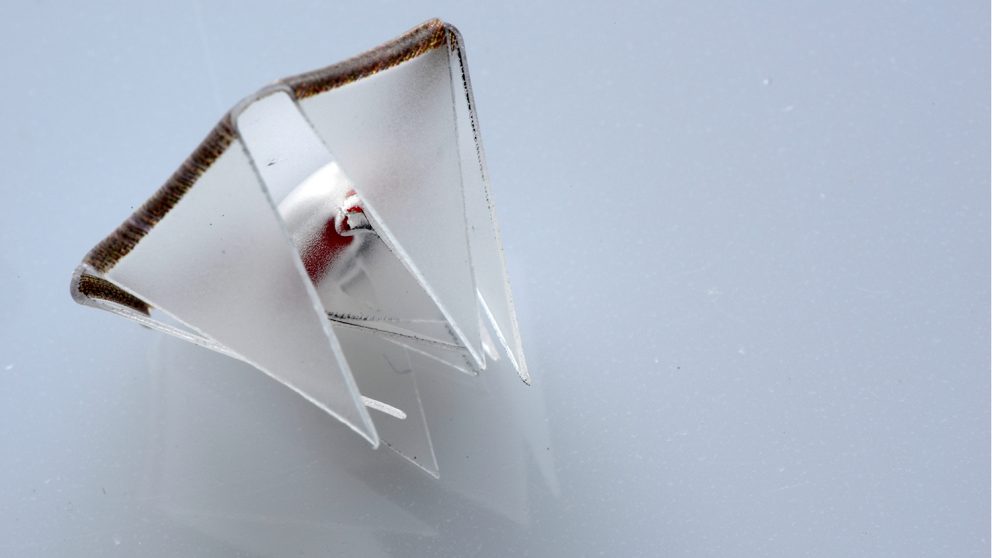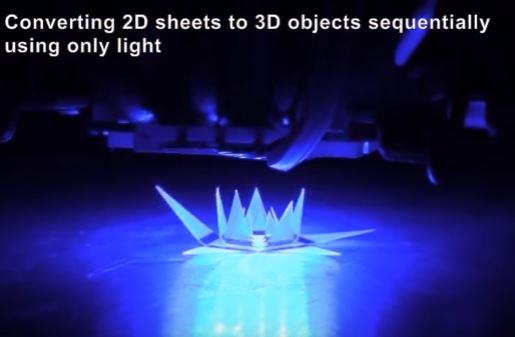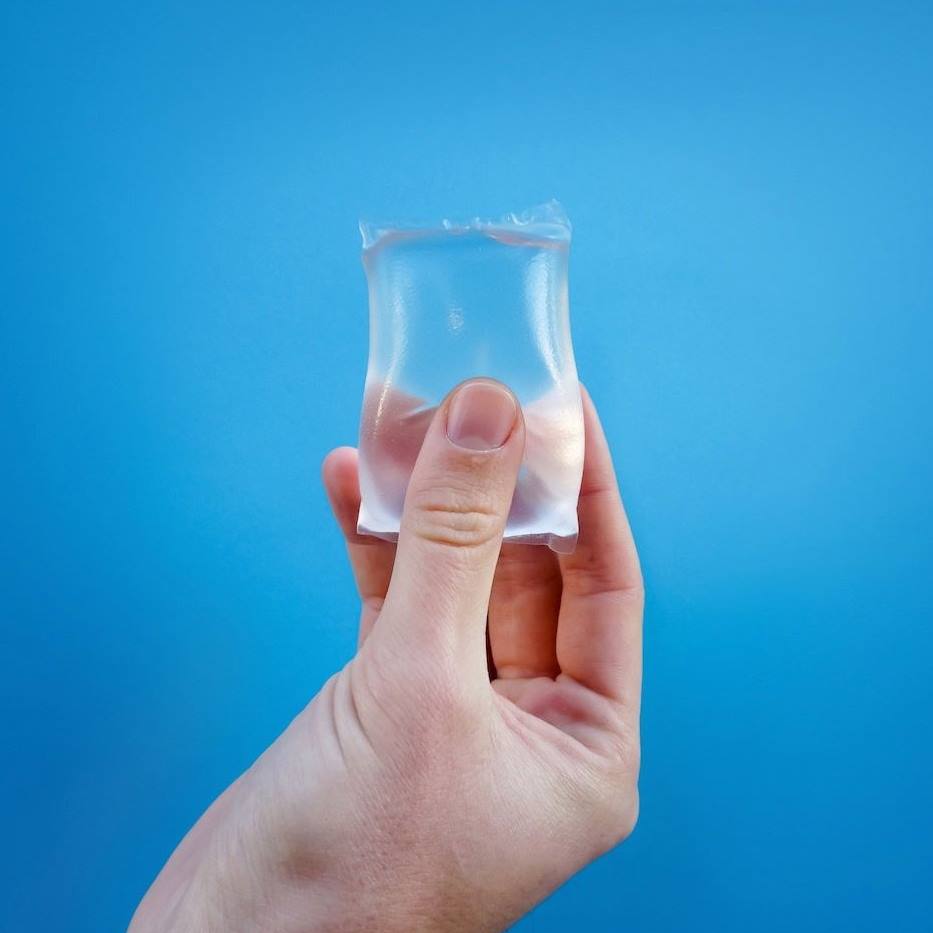
A Japanese legend declares that anyone who folds “senbazuru,” or 1000 origami cranes, will be granted a wish. But if that folding task seems a bit overwhelming, some scientists at North Carolina State University (NCSU) might have just the trick—and one that’s almost as easy as tossing a penny in a wishing well: self-folding materials.
Building on research they first completed in 2011, the NCSU team recently discovered that they could coax flat plastic sheets to fold themselves into various geometric shapes by shining infrared light of varying frequencies on thin colored lines printed on those sheets. In practical terms, when an infrared light shines on them, those colored lines become “energy absorbers” and constrict. As they shrink, they pull on the material on either side of the line in a way that “pushes up” that adjacent material into pre-prescribed shapes or forms.
Lighting the Way to an Extra Dimension

The research team’s original research relied on a remarkably simple idea—and similarly basic materials.
The proverbial three-ingredient recipe? A pre-pressed polymer sheet, an inkjet printer and an infrared light. That’s it. The four-person team (Ying Liu, PhD, Julie K. Boyles, Jan Genzer, PhD, and Michael Dickey, PhD) found that black lines printed on the polymer sheets would absorb more energy from infrared light than the adjacent plastic. So the polymer sheet won’t contract on those lines, but will everywhere else. Flat, two-dimensional patterns—like the square and four triangles that make up the base and sides of a simple pyramid, for instance—can suddenly “pop up” when exposed to the infrared lamp.
That same 2011 research by Liu et al also found that the direction the plastic should fold could be altered by changing which side of the material held the printed lines. Along similar lines, they discovered that they could vary how much—and how fast—the polymer would bend by adjusting the width of the black lines: Thicker lines, for instance, would absorb more energy, meaning they’d fold faster than their thinner counterparts.
The Next Step: Adding a Splash of Color
A video showcasing NCSU’s 2011 research also threw a spotlight on one key limitation of the new process: Exposure to the infrared light would cause all of the folds to begin at the same time. While that wouldn’t necessarily be a problem for simple shapes like, say, a cube, it would present a considerable challenge for more complex shapes that require that the folds take place in a specific order.
“A longstanding challenge in the field has been finding a way to control the sequence in which a 2-D sheet will fold itself into a 3-D object,” said Dickey in a news release announcing the new findings in March, 2017. “And as anyone who has done origami—or folded their laundry—can tell you, the order in which you make the folds can be extremely important.”

Building on their prior research, the team substituted black lines with colored lines. Since different colors absorb wavelengths of light at different rates, they found that they could control the sequence the hinges would fold by varying both the color of the line and the color of the light used.
For example, a polymer sheet that featured red and yellow lines could be “triggered” to fold only the yellow lines if it was exposed to a red light, since the red-colored lines wouldn’t absorb the red light. Ditto with the yellow lines and their influence under yellow light. In short, changing both the color of the lines and the color (or frequency, really) of the light shown on them can impact how a two-dimensional pattern could be “programmed” to take on a three-dimensional shape.
Dickey describes the team’s most recent work as a “proof-of-concept paper,” but the potential applications for self-folding materials are intriguing.
Shipping containers—which could be folded flat and then sprung into shape on-site—could be a natural application. So, too, would cases where having human hands do the folding would be less-than-desirable, such as in a clean-room or lab setting. NCSU’s team also sees potential to apply the technology on both micro and macro levels, from the unfolding of proteins to the unfurling of solar panels on satellites.
And then there’s the promise of large-scale production: Cranking out 1,000 cranes in a moment’s time would be a wish come true for a budding origamist who can’t quite get the hang of it (or, worse yet, suffers from unending paper cuts).
The Innovation, Inspiration & Ideas blog was created to share stories and profiles of companies, products and individuals creating innovation in business through inventive material solutions. For more information on why we launched it, read our blog introduction.
Also in Industry Inspiration:

Using Carbon Dioxide to Make Plastics
in Industry InspirationScientists at Rutgers have developed catalysts that can convert carbon dioxide into plastics, resins, fabrics and more. Since carbon dioxide has been identified as a major cause of… Read More

Edible Water Bottles: the next big thing?
in Industry InspirationEdible water bottles could be in your future thanks to London-based startup Skipping Rocks Lab. Their first product, Ooho, makes you rethink “water on the go.” The idea behind Ooho… Read More
